Groundwater at Old Point Comfort
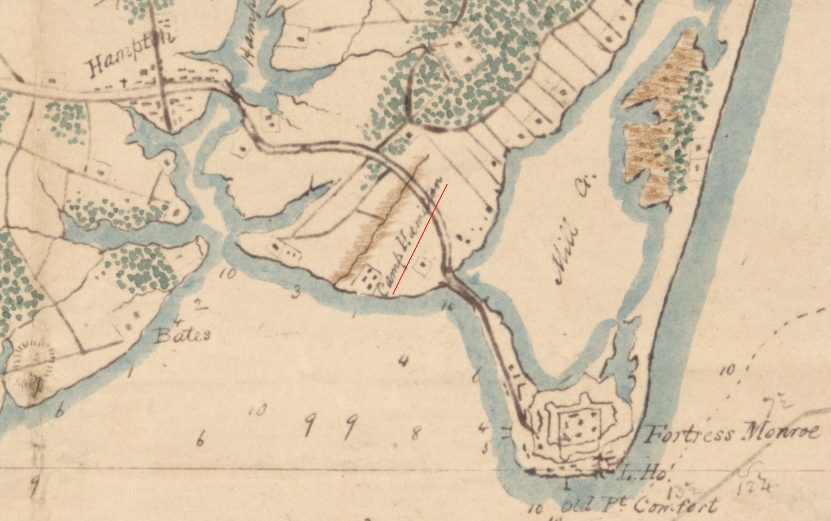
inadequate water supply for the additional troops arriving at Fort Monroe in 1861 led to the "invasion" of Virginia and creation of Camp Hamilton
Source: Library of Congress, Extract from Fort Monroe, Norfolk, Suffolk, and Yorktown, with their connections and surroundings for military purposes
After Fort Monroe was constructed in 1822, shallow wells and cisterns capturing rain provided adequate amounts of drinking water. When Massachusetts troops arrived to reinforce the fort in 1861 at the start of the Civil War, the existing cisterns and shallow wells could not supply the additional water needed by the additional people.
The absence of fresh water triggered the Union commander at Fort Monroe to "invade" Virginia in order to access a fresh water well on the western side of Mill Creek. On May 13, Federal forces crossed the bridge over Mill Creek and seized control of the well.
The outnumbered Confederate officials decided to withdraw and avoid armed conflict at a location within range of the cannon at Fort Monroe. The Union Army established what became known as Camp Hamilton in what was then Elizabeth City County, and is now within the boundaries of the City of Hampton.
Camp Hamilton was never attacked. Instead, a month later the two sides fought at Big Bethel. Camp Hamilton evolved into a site for escaped contrabands known as Slabtown.1
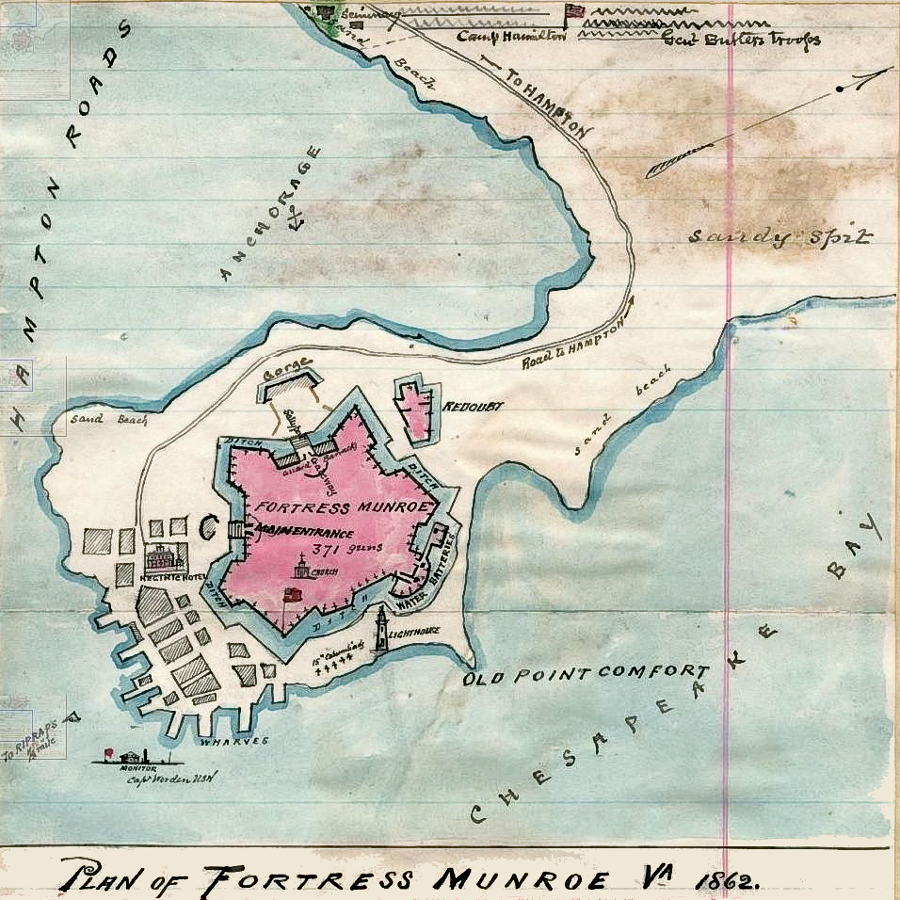
Robert Knox Sneden sketched Fort Monroe and Camp Hamilton in 1862
Source: Virginia Historical Society: "A Guide to the Robert Knox Sneden Scrapbook Inventory," Plan of Fortress Munroe Va. 1862
The US Army started drilling a well on Old Point Comfort in 1864 to provide additional drinking water. When the US Army stopped digging in 1869 five years of drilling, they had reached a depth of 907 feet but the well still produced only saline water.2
The Hygeia Hotel brought drinking water by boat from Norfolk, then dug wells on the mainland at the Soldier's Home in Hampton. In 1894 the Federal government also dug several wells on the other side of Mill Creek and piped water under the creek to Fort Monroe. That water became too brackish when the community of Phoebus grew, and other wells in the area skimmed off fresh water in the aquifer.
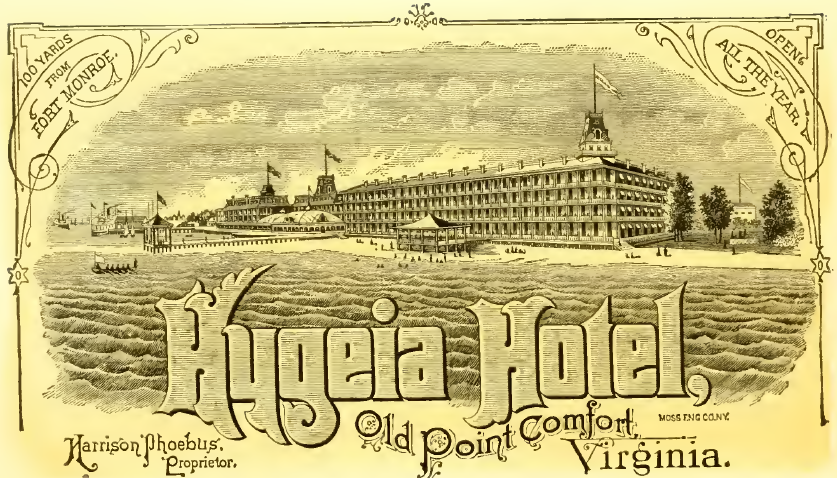
hotels as well as Fort Monroe struggled to find a reliable supply of safe, fresh drinking water
Source: Internet Archive, Old Point Comfort, Va. - Album of Views (1883)
In 1896 The Chamberlin hotel drilled a well 945 feet deep, but it produced the "saltiest and most mineralized water yieled by any flowing well in the Norfolk-Newport News area."3
The water was used only for flushing, because the well water contained too much iron and other minerals for use in boilers, laundry, or bathing. After the Hygeia Hotel was removed in 1902, The Chamberlin used the old wells on the mainland at the Soldier's Home in Hampton for cleaning purposes, but distilled the water offered to customers for drinking.
It advertised in 1912:4
- The water is free from contamination. But, just to make assurance doubly sure, it is distilled, while every item of food can pass a triple examination by the pure food experts...
- ...UPON ELECTROSCOPIC TESTS THIS WATER HAS SHOWN DEFINITE RADIO ACTIVE PROPERTIES, which necessarily perform a part in its therapeutic action. For cases in which our Medical Director deems it advisable to administer this Water with a higher degree of Radio Activity as in severe Gout, Sciatica and Rheumatism — arrangements have been made for powerfully activating this Water. Taken under the advice and direction of our Physician, at regular periods of the day, in specific quantities, and at regular temperature, the effect of this Water is beneficial in every particular; in fact, some cures have been made which have been pronounced practically incurable
after drinking other waters.
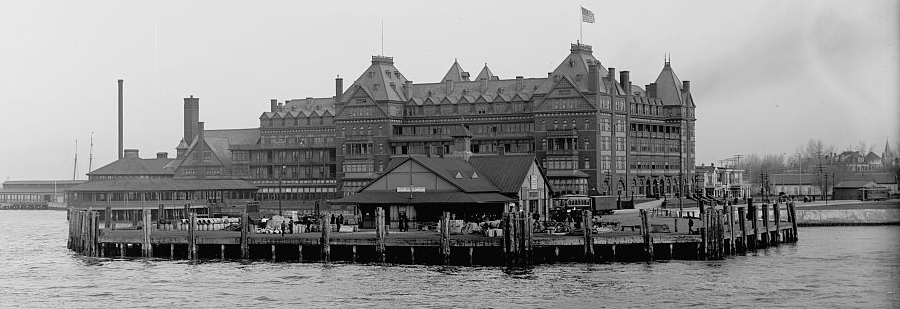
The Chamberlin was built in 1896 next to the Hygeia Hotel, adding to the demand for fresh water on Old Point Comfort
Source: Library of Congress, Hotel Chamberlin, Old Point Comfort, Virginia
During the Spanish-American War, a water distillation plant was built to serve the hospital located at the fort. The drinking water plant provided more fresh water and helped to reduce the number of cases of typhoid, but soldiers found the water's taste to be unpalatable and were tempted to use other sources.5
In 1902, the US Army drilled another well deep through the soft sediments. The drillers hit crystalline bedrock at 2,240 feet, then went went eight feet deeper. They used dynamite to fracture bedrock at two levels to increase flow into well, but despite the depth the well's water was too saline for use.
Fort Monroe ultimately decided to purchase water from a private company at Newport News. That company later became the Newport News Waterworks municipal utility, and still supplies drinking water to Old Point Comfort.
The modern source is surface water from the Chickahominy River, plus brackish water from groundwater wells near Lee Hall. The utility uses reverse osmosis at a desalination plant to remove salt from the wells and then blends the two sources before distribution. The moat around the fort - and the fire hydrant system - are salt water.6
The mysterious absence of fresh water at such great depth was a clue that helped lead to the discovery that an asteroid or comet (bolide) had struck the area 35 million years ago, disrupting the aquifers.
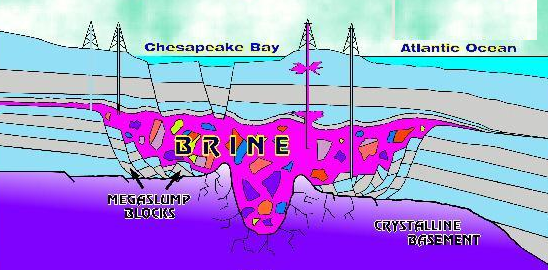
even deep wells drilled at Old Point Comfort found only saline water, due to disruption of aquifers by a bolide's impact 35 million years ago
Source: US Geological Survey (USGS), Chesapeake Bay Bolide
Links
References
1. "Foundation Document - Fort Monroe National Monument," National Park Service, July 2015, p.10, http://www.nps.gov/fomr/learn/management/upload/FOMR_FD_2015.pdf; Fort Monroe: Key to the South, John V. Quarstein, Dennis P. Mroczkowski, Arcadia Publishing, 2000, p.30, https://books.google.com/books?id=kSZv7unExEQC; John V. Quarstein, Dennis P. Mroczkowski, Fort Monroe: The Key to the South, Arcadia Publishing, 2000, pp.30-31, https://books.google.com/books?id=kSZv7unExEQC (last checked August 30, 2015)
2. William Bullock Clark, Benjamin LeRoy Miller, Edward Wilber Berry, Thomas Leonard Watson, "The Physiography and Geology of the Coastal Plain Province of Virginia," Bulletin, Virginia Division of Mineral Resources, No. IV, 1912, pp.99-104, p.162, https://books.google.com/books?id=XSwQAAAAIAAJ (last checked December 26, 2014)
3. D. J. Cederstrom, "Geology and GroundWater Resources of the York-James Peninsula, Virginia," Geological Survey Water-Supply Paper 1361, US Geological Survey, 1957, p.221, https://pubs.usgs.gov/wsp/1361/report.pdf (last checked January 24, 2017)
4. William Bullock Clark, Benjamin LeRoy Miller, Edward Wilber Berry, Thomas Leonard Watson, "The Physiography and Geology of the Coastal Plain Province of Virginia," Bulletin, Virginia Division of Mineral Resources, No. IV, 1912, pp.161-162, https://books.google.com/books?id=XSwQAAAAIAAJ; "Hotel Chamberlin, Old Point Comfort, Va.," 1912, https://archive.org/details/hotelchamberlino00newy (last checked January 24, 2017)
5. "Report of the Surgeon General," Annual Reports of the War Department, Government Printing Office, 1904, p.141, https://books.google.com/books?id=AARHAQAAIAAJ (last checked January 24, 2017)
6. "2013 Consumer Confidence Report on the Quality of Tap Water at Fort Monroe," Fort Monroe Authority, 2015, http://www.fmauthority.com/wp-content/uploads/2015-Consumer-Confidence-Report-on-Quality-of-Tap-Water.pdf (last checked January 24, 2017)
Groundwater in Virginia
Virginia Places




